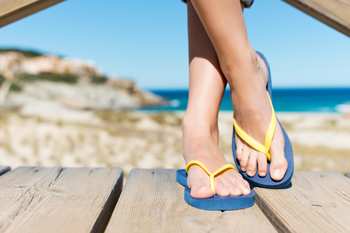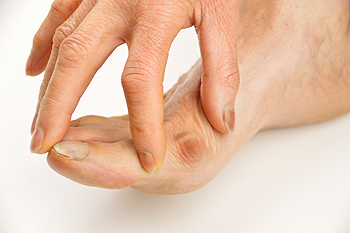Items filtered by date: August 2022
How Does a Broken Foot Happen?

A broken foot can cause severe pain and discomfort. It usually happens suddenly, often as a result of a car accident, a fall, or if a heavy object should fall on the foot. The symptoms that many people experience with a broken foot include extreme pain, swelling, and the ankle and surrounding areas can be bruised. If the fracture is severe, the bone may protrude through the skin, and can look deformed. Additionally, it is often difficult to walk, and immediate medical attention is often sought. A proper diagnosis is generally performed, and this is helpful in ruling out sprains. Numbness and a tingling sensation may accompany the broken foot, and it may feel cold and look red. Most broken feet are treated by wearing a cast or a walking boot, which can provide the stability that is needed as the healing process takes place. A general time frame for complete healing is approximately six weeks, and many people use crutches that can help to take the weight off of the foot. If you have endured a broken foot, please consult with a podiatrist who can help you with the right treatment, so you can start to feel better.
A broken foot requires immediate medical attention and treatment. If you need your feet checked, contact one of our podiatrists from Podiatry Associates of Victoria. Our doctors can provide the care you need to keep you pain-free and on your feet.
Broken Foot Causes, Symptoms, and Treatment
A broken foot is caused by one of the bones in the foot typically breaking when bended, crushed, or stretched beyond its natural capabilities. Usually the location of the fracture indicates how the break occurred, whether it was through an object, fall, or any other type of injury.
Common Symptoms of Broken Feet:
- Bruising
- Pain
- Redness
- Swelling
- Blue in color
- Numbness
- Cold
- Misshapen
- Cuts
- Deformities
Those that suspect they have a broken foot shoot seek urgent medical attention where a medical professional could diagnose the severity.
Treatment for broken bones varies depending on the cause, severity and location. Some will require the use of splints, casts or crutches while others could even involve surgery to repair the broken bones. Personal care includes the use of ice and keeping the foot stabilized and elevated.
If you have any questions please feel free to contact our office located in Victoria, TX . We offer the newest diagnostic and treatment technologies for all your foot and ankle needs.
Ways Diabetes Affects the Feet

When people think of diabetes, they often think of blood sugar and insulin. Diabetes can have several side effects, many of which affect the feet. Sustained high blood sugar levels can affect both the nerves and the blood vessels. One condition is called diabetic neuropathy in which the nerves that send messages to the lower legs, ankles, feet, and toes become damaged. This results in numbness, tingling, and pain in the feet. Diabetes can also restrict blood flow to the feet, which can prevent sores or cuts from healing properly and in severe cases lead to gangrene or even amputation. Managing the condition of the feet is an everyday concern for a diabetic. It starts with a daily examination to look for cuts or sores, especially on the bottom of the feet. It is also important to wear comfortable shoes and clean socks that give the feet ample room to breathe. Keeping the feet active through simple exercises designed to increase blood flow is important too. For more information and other foot care remedies, it is strongly suggested that you make regular visits to a podiatrist for evaluation and guidance.
Diabetic foot care is important in preventing foot ailments such as ulcers. If you are suffering from diabetes or have any other concerns about your feet, contact one of our podiatrists from Podiatry Associates of Victoria. Our doctors can provide the care you need to keep you pain-free and on your feet.
Diabetic Foot Care
Diabetes affects millions of people every year. The condition can damage blood vessels in many parts of the body, especially the feet. Because of this, taking care of your feet is essential if you have diabetes, and having a podiatrist help monitor your foot health is highly recommended.
The Importance of Caring for Your Feet
- Routinely inspect your feet for bruises or sores.
- Wear socks that fit your feet comfortably.
- Wear comfortable shoes that provide adequate support.
Patients with diabetes should have their doctor monitor their blood levels, as blood sugar levels play such a huge role in diabetic care. Monitoring these levels on a regular basis is highly advised.
It is always best to inform your healthcare professional of any concerns you may have regarding your feet, especially for diabetic patients. Early treatment and routine foot examinations are keys to maintaining proper health, especially because severe complications can arise if proper treatment is not applied.
If you have any questions please feel free to contact our office located in Victoria, TX . We offer the newest diagnostic and treatment technologies for all your foot and ankle needs.
Tips for Wearing Flip Flops

Flip-flops are undoubtedly a convenient kind of footwear. Not only are they fashionable, but they are also very easy to slip on during the warm summer months. However, they can wreak havoc on the health of your feet for many different reasons. Most importantly, flip-flops can be bad for your feet because they force the feet to work overtime to keep the shoe on the foot. For example, flip-flops lack a back strap of any kind causing the foot must scrunch up into unnatural contortions to keep the flip-flop in place. This type of shoe can be dangerous because the piece of foam resting underneath the sole of the foot offers little to no support. Additionally, many kinds of flip-flops are made using plastic and that plastic material can cause blisters and irritate the skin. If you must wear flip-flops, consider wearing them selectively. For instance, you might wear them only to walk down the block or from the car to the beach instead of on long walks or hikes. For more information about this kind of footwear, reach out to a trusted podiatrist.
Flip-flops are not always the best choice of footwear. If you have any concerns about your feet or ankles, contact one of our podiatrists from Podiatry Associates of Victoria. Our doctors will assist you with all of your foot and ankle needs.
Flip-Flops and Feet
When the weather starts warming up, people enjoy wearing flip-flops. Flip-flops are comfortable, stylish, and easy to slip on and off; they're perfect for any summer beach goer. However, these shoes can cause harm to the feet.
How Can Flip-Flops Affect Me Long-Term?
- Ankle problems
- Hip problems
- Lower back problems
- Pain in the balls of the feet
- Problems with foot arches
- Changes in the way you walk
Are There Injuries Associated with Flip-Flops?
Yes. Since flip-flops are relatively weak and do not provide the same amount of support as sneakers, people who wear flip-flops regularly are more susceptible to injuries. On top of that, the open nature of the shoe makes your feet more prone to other problems, such as cuts and even infections. Common injuries and ailments include:
- Sprained ankles
- Blisters
- Infections
- Cuts and Scrapes
I like Wearing Flip-Flops. Are There Safe Alternatives?
When buying flip-flops, try to find ones that have sturdy soles and that are made of high-quality materials that will support for your feet. These flip-flops will cost more but will also last longer as a result.
If you have any questions please feel free to contact our office located in Victoria, TX . We offer the newest diagnostic and treatment technologies for all your foot and ankle needs.
Why Live with Pain and Numbness in Your Feet?
Bunions Can Cause Cosmetic and Physical Concerns

Many people who have bunions are concerned that it is a cosmetic condition. There are some patients who are aware they may cause pain, and this can hinder completing daily activities. The medical term for a bunion is referred to as hallux valgus, and it is defined as a bony lump on the side of the big toe. It gradually develops from genetic reasons, or from wearing shoes that do not have enough room for the toes to move freely in. It will begin as a small bump, and will gradually increase in size if the same type of shoes are frequently worn. It can affect the other toes by pushing against them, and this can cause them to shift. Some patients develop corns and calluses on top of the shifted toes, and bursitis can develop in the affected joint of the big toe. There are protective pads that can be worn over the bunion until larger shoes are purchased. If you see the first sign of a bunion, or if it has increased in size, it is strongly advised that you are under the care of a podiatrist who can possibly recommend surgery for permanent relief.
If you are suffering from bunions, contact one of our podiatrists of Podiatry Associates of Victoria. Our doctors can provide the care you need to keep you pain-free and on your feet.
What Is a Bunion?
A bunion is formed of swollen tissue or an enlargement of boney growth, usually located at the base joint of the toe that connects to the foot. The swelling occurs due to the bones in the big toe shifting inward, which impacts the other toes of the foot. This causes the area around the base of the big toe to become inflamed and painful.
Why Do Bunions Form?
Genetics – Susceptibility to bunions are often hereditary
Stress on the feet – Poorly fitted and uncomfortable footwear that places stress on feet, such as heels, can worsen existing bunions
How Are Bunions Diagnosed?
Doctors often perform two tests – blood tests and x-rays – when trying to diagnose bunions, especially in the early stages of development. Blood tests help determine if the foot pain is being caused by something else, such as arthritis, while x-rays provide a clear picture of your bone structure to your doctor.
How Are Bunions Treated?
- Refrain from wearing heels or similar shoes that cause discomfort
- Select wider shoes that can provide more comfort and reduce pain
- Anti-inflammatory and pain management drugs
- Orthotics or foot inserts
- Surgery
If you have any questions, please feel free to contact our office located in Victoria, TX . We offer the newest diagnostic and treatment technologies for all your foot care needs.
Choosing Running Shoes for Different Terrains

Going shoe shopping for runners can be incredibly difficult. With so many options to choose from, different brands, and different styles, selecting a running shoe can often feel daunting and impossible. However, there are certain guiding rules that you might consider keeping in mind when going shoe shopping. One guiding principle to bear in mind is that the type of running shoe that you select ought to be a good fit for the type of terrain that you are running on. For example, runners ought to consider whether they are primarily running on treadmills, tracks, streets/sidewalks, paths, or hills. Each type of terrain calls for different features in a running shoe. Namely, running on hard surfaces such as streets or sidewalks requires the running shoe to be heavily cushioned. You might look for a running shoe with hefty cushions and padding material around the heel. Running on tracks, however, requires the running shoe to have spikes so that you can grip the track and increase your speed. Lastly, if you are running on outside terrain such as a hill or an outdoor path, you could consider shopping for a running shoe that is weather resistant and significantly durable. If you are a runner in the market for a good pair of running shoes, contact a podiatrist who can help you in your search.
If you are a runner, wearing the right running shoe is essential. For more information, contact one of our podiatrists from Podiatry Associates of Victoria. Our doctors can provide the care you need to keep you pain-free and on your feet.
Choosing the Right Running Shoe for Your Foot Type
To increase performance and avoid the risk of injury, it is important to choose the right running shoe based on your foot type. The general design of running shoes revolves around pronation, which is how the ankle rolls from outside to inside when the foot strikes the ground.
- Neutral runners are able to choose from a wide variety of shoes, including minimalist shoes or even going barefoot.
- Runners who overpronate, or experience an over-abundance of ankle rolling, should choose shoes that provide extra motion control and stability.
- Runners who underpronate, or supinate, have feet that have high arches and lack flexibility, preventing shock absorption. They require shoes with more flexibility and cushion.
If you have any questions please feel free to contact our office located in Victoria, TX . We offer the newest diagnostic and treatment technologies for all your foot and ankle needs.

